The history of artificial ventilation: how to rescue people from biblical times to the present day
Categories: Health and Medicine | Technology | World
PictolicThe basic principles on which we breath in hospitals today was invented many centuries ago. But came up with and alternative. Why don't they always work?
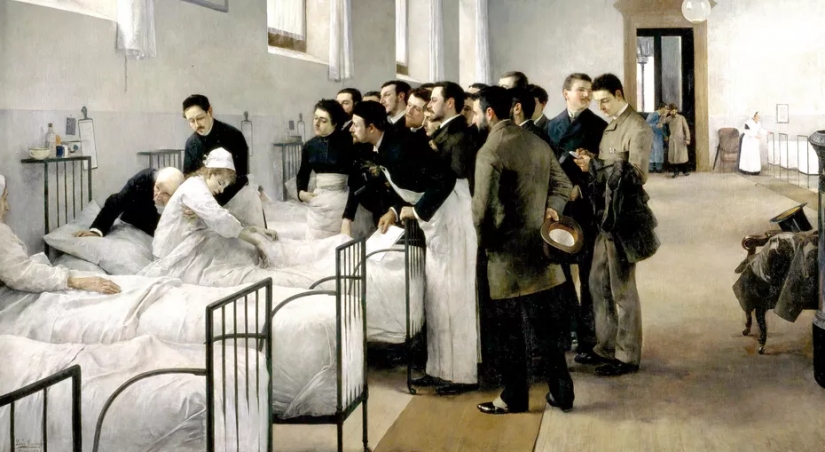
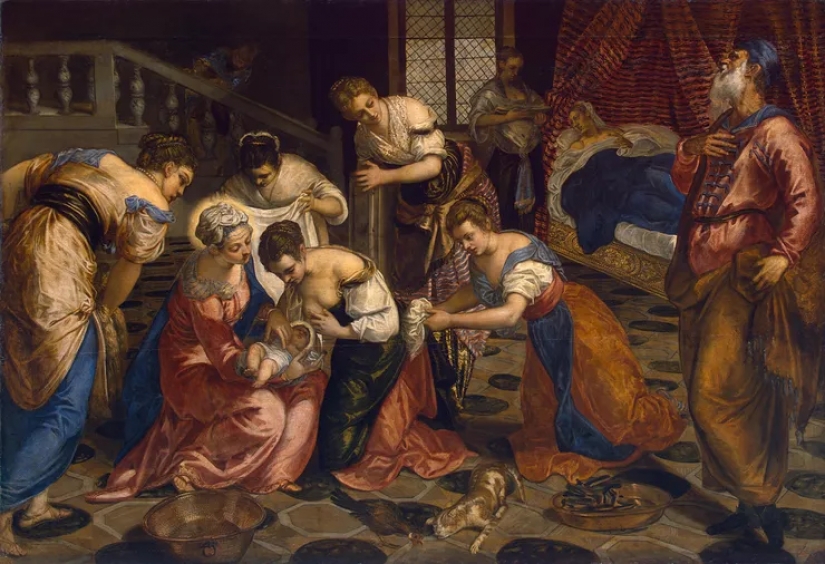
To deliver the air into the human lung, which he cannot do a breath — an idea that came to mind for a long time. So that artificial ventilation for a long time. Yes, actually it is possible without special modern devices: refers to any artificial pulmonary ventilation (inhalation and exhalation) that the person does not produce on its own.
In the school safety taught, for example, to do the simplest of its kind: mouth-to-mouth. And readers who have older relatives from the village could hear their stories about how "I rastyagivanie" pigs or lambs, which are born, not screamed.
Some see evidence that these techniques were known to people thousands of years ago in the Bible. We are talking about the episode with the prophet Elijah breathed life into a boy. However, many doubt such a medical advancement of a prophet and I believe that these words are used as a way.
In fact, foreseeable, neverthesame, past "breathed life" only midwives in newborn, if something went wrong — and Yes, the shepherds in lambs and piglets. Cases when thus tried to regain the breath the man who has it for some reason stopped, probably can be counted on the fingers.
In the end, breathing in an adult is usually not suppressed just in addition to direct delivery of air into the lungs still need some resuscitation measures, and the corresponding specialized equipment. Of course, in some of antiquity to take him was nowhere.

Asclepiad
And yet, in antiquity, there was the first attempt to ease breathing to a person who is already starting to lose it. The doctor Asclepiad known fact that he preferred to treat patients with an established diet, exercise and wine (Yes, it is in this combination), invented to make the incision on the trachea, by establishing the end of the reed and blow to fill your lungs with air.
This method is supposed to eliminate problems with the language or something that could be in the throat and clogging it. Later, this method was rediscovered in the sixteenth century physician Wasalam.
The Renaissance is generally an interesting number of rediscovered ancient scientific works. The fact is that it began around the fall of the Byzantine Empire. Many Byzantine refugees, including scholars with their libraries and knowledge of classical Greek language, rushed away from the Turks in Europe.
In Europe, it turned out that you can live very well, having taught Greek, and all the same disciplines as in the Byzantine schools. And it turned out that the monasteries are not only Holy books but also old medical treatises that long no one can read.
The most cunning students of Greek teachers immediately began to show the world their open — exactly coincides with the discoveries of ancient authors. It is unknown whether cheated as well and Vesalius, but the suspicions are there.
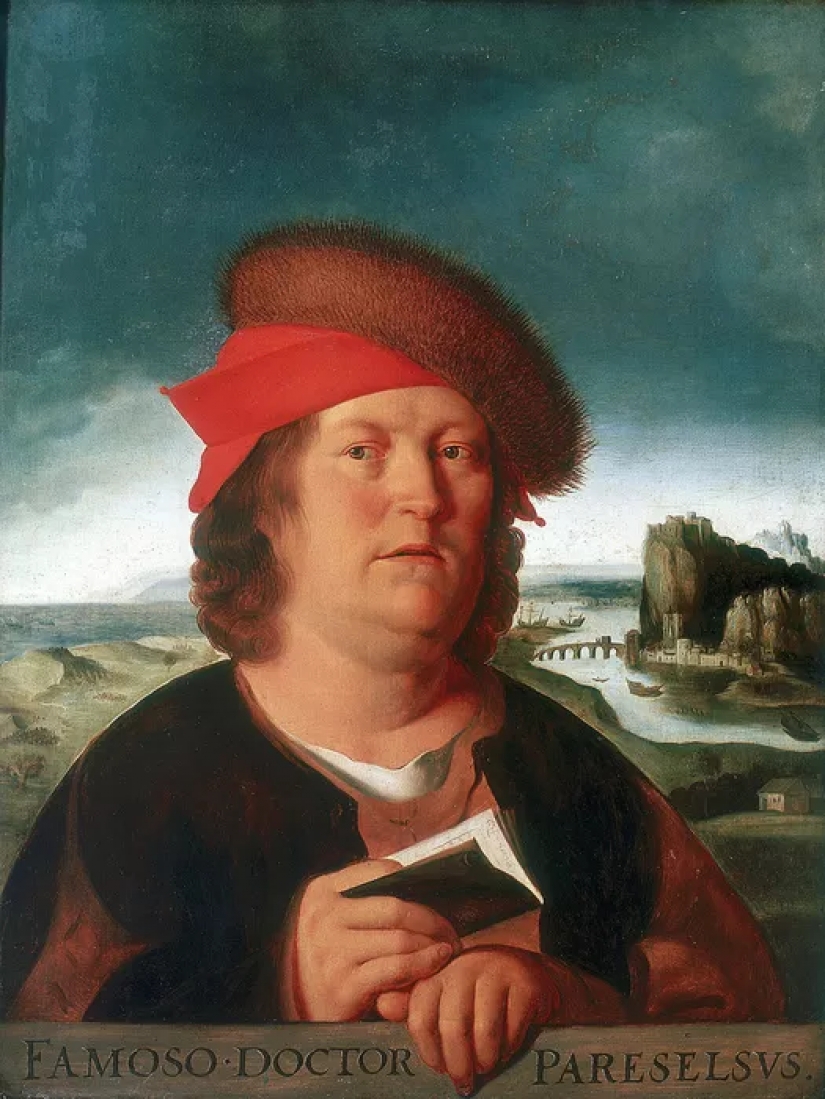
Probably, it is not surprising that the first mechanical device for blowing air was invented in the Renaissance. Not only Leonardo at the time raved about the cars for different purposes. The legendary Swiss physician Paracelsus constructed a handheld device ventilation from the air duct, insert into the mouth of the patient, and leather fireplace bellows — similar to forging, but much weaker.
The latter was very important because too strong a jet of air can break the lungs. For this reason, small children CPR doing is not the same as adults, and this risk of people who is in the grip of a hurricane (if, of course, not hit anything too hard or covered with snow or mud).
So, the history of devices for artificial ventilation of lungs it is possible to start from 1530, when Paracelsus successfully used his invention. However, this device still could not be called a machine. It worked on clean power of hands.
The invention of Paracelsus gained fame, but in fact little used by physicians. There were several reasons. First, patients whose breath was required to recover, still required very often and other resuscitation measures, and for them nothing was invented. Second, the Paracels and Flack as a charlatan.
That one will come up with something else — and anything that he offers and applies, I imagine, have no respectable Greek and Roman authors!
However, one or the other, the doctor risked to apply the mantel-fur — and kind of a scandal. But in the eighteenth century, when the world is once again obsessed with machines and mechanisms, of course, of interest to medical devices of a different sort broke out with renewed vigor. A few inventors improved the fur for the injection of air and also got the idea to make them different for infants and adults.
Just about this time learned to distinguish and pure oxygen so that oxygen and devices for ventilating the lungs almost immediately joined: the effect obtained from this much more noticeable. But many now think the oxygen tent, the world learned only in the twentieth century...
Already a popular (not medical!) the manual, published in 1799 in St. Petersburg, it is recommended to use "razdevalnaya bag" resuscitation of the dead, frozen, udivishsya, fallen into a swoon or anyone who looks dead. Probably razdevalnaya bags can be bought in any drugstore of a large city — along with the enema, gag, and other popular tools.
All the same, such assistance are often maimed and killed saving — too zealous lifeguard. The efficiency of artificial lung ventilation has increased dramatically only in 1821 when Frenchman Le Roy d Athol invented measuring ruler to adjust the volume of the injected air into his lungs.
But by the time this method has acquired such a bad reputation that almost to the end of the nineteenth century doctors completely or almost completely switched to the old, proven way mouth to mouth combined with chest compressions.
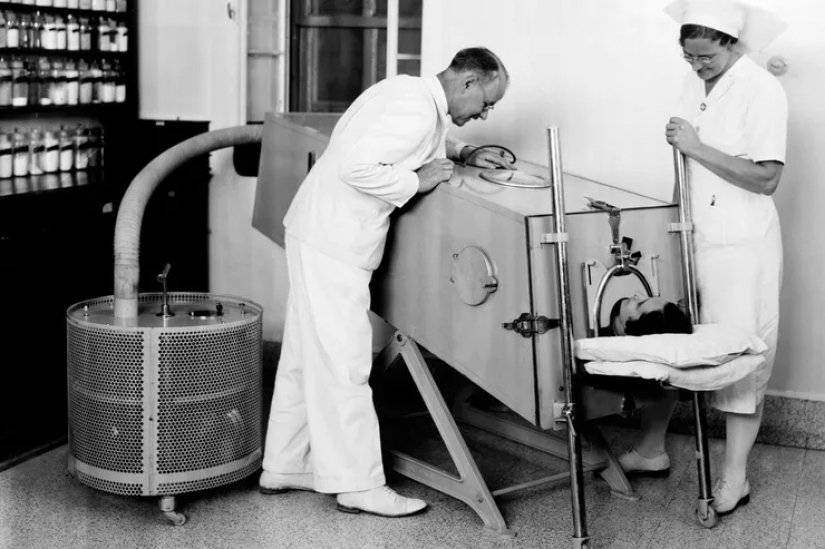
The first modern and practical respirator "Iron lung"
For a long time the improvement of devices for artificial lung ventilation was associated with such things as the improvement of the process and instruments for intubation (installation in the throat of the tube connected to the bellows) or transfer of the device from a purely manual mode to work on foot or electric drive. In fact, the ventilator, was developed and applied already in the first half of the twentieth century.
But there was another way to artificially force a person to breathe. He saved the victims of the terrible epidemic of disease that we have already forgotten due to vaccination: polio. In the twentieth century polio as a fire swept through Europe and the United States. Tens of thousands of children fell ill and was paralyzed.
Some have disabilities, others have died — those who have developed paralysis of the respiratory system. Needed a machine that would help children to breathe as much as you need — days, months and years. Here and thought about a strange invention of a German doctor Sauerbruch, which he tried before the First World war to replace the lung. It was a sort of chamber.
Special pumps that pumped out of the chamber, similar to the barrel of the air, making it sparse and forcing due to this the lungs to swell and make a "breath", that pumped the air, compressing the lungs so that they have made "exhale". Naturally, the patient's head was outside — that was that "inhale" and "exhale".
In 1928 in a pressure chamber placed the eight-year girl died from suffocation... And she immediately felt better! The device replaced the work her muscles.
After the Second World chamber modified — equipped with mirrors so you can see what is happening around, improve the mechanism, and it became known as the device of His or iron lung. To produce these devices had on an industrial scale. The epidemic is not just back, she took the daunting size.
Alternatively, for older children then came up and the device is smaller, Krasny — that is, like the cuirass, covering the body only. With this device the patient can drive the wheelchair, which, of course, has greatly improved his life.
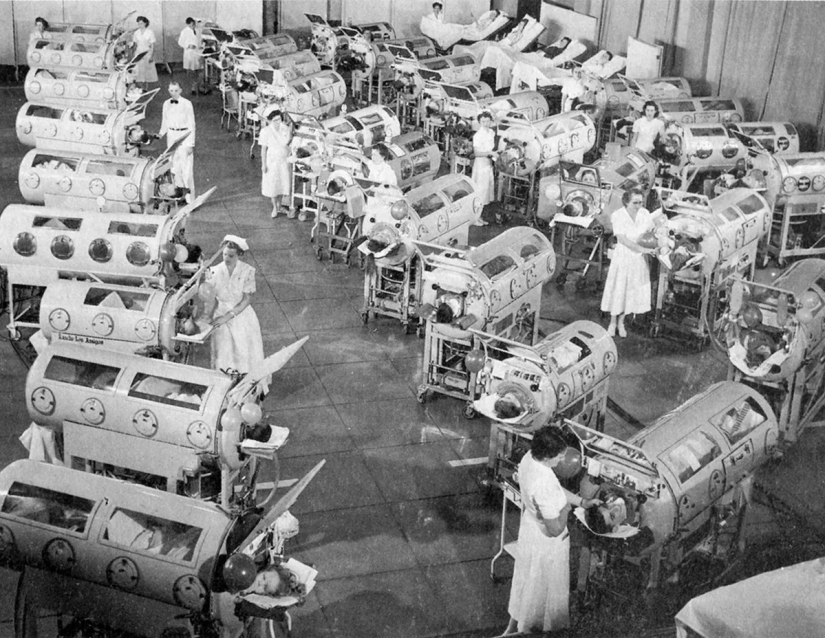
The same children who were placed in the apparatus Engström, could start to breathe a few months for yourself... or remain dependent on a breathing apparatus for life. As lucky. Often, those who traveled in Krasnom apparatus, the night moved into the chamber — it was more comfortable. Many of those who first came to the office Engström, live through him still.
The most famous of people who survived through this chamber, — the actress MIA Farrow, former shining star of Hollywood in the seventies. Horror lovers adore her in the lead role in the movie "rosemary's Baby". So, if MIA was not in the chamber for the months that her lungs have stopped working due to polio, rosemary we would remember completely different.
Most of the less fortunate. Now a few elderly people depend on, will not be violated if due to the bad weather the supply of electricity, whether there will be some minor breakage when they are alone in the room, and will continue to produce collars for the chamber — they should be changed every few months due to the loss of integrity, and they are becoming more expensive due to the fact that they produce less.
Journalist Jennings brown, who tried to lie down in this chamber, said that it you feel like a vacuum cleaner: you can not control your breath, you just "breathe".
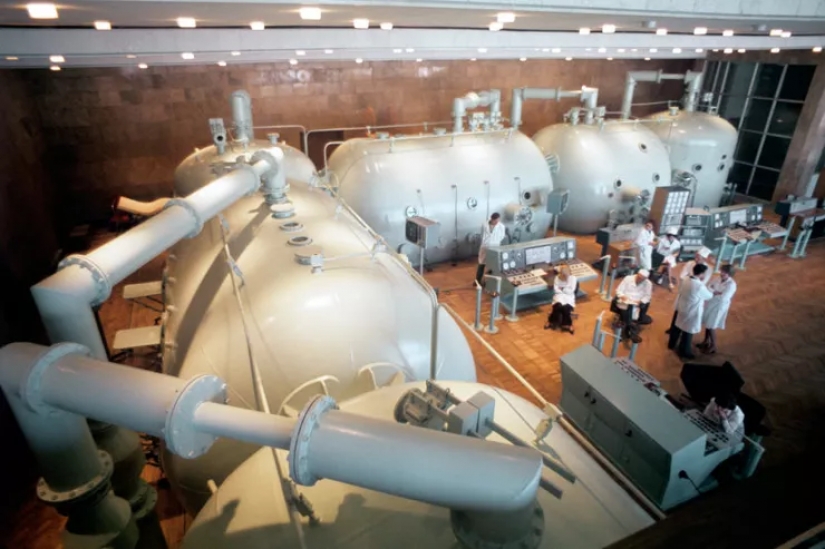
Center for hyperbaric oxygenation. The main hall with hyperbaric chambers
In the early fifties of the founder of the intensive care unit of Neurology NTS Love Popov scholarship who were sent to Sweden and Denmark to learn from the experience. The website med-history quoted Dmitry Sergeeva, the employee of branch of resuscitation of Scientific center of neurology:
In 1964, under the auspices of the domestic Popova created the first ever ventilator working on the principle of "management pressure" DP-8 (it now somewhere working). Records duration IVL: post-polio simple lung ventilator supported breath over 23 years, with lateral amyotrophic sclerosis — up to 14 years.
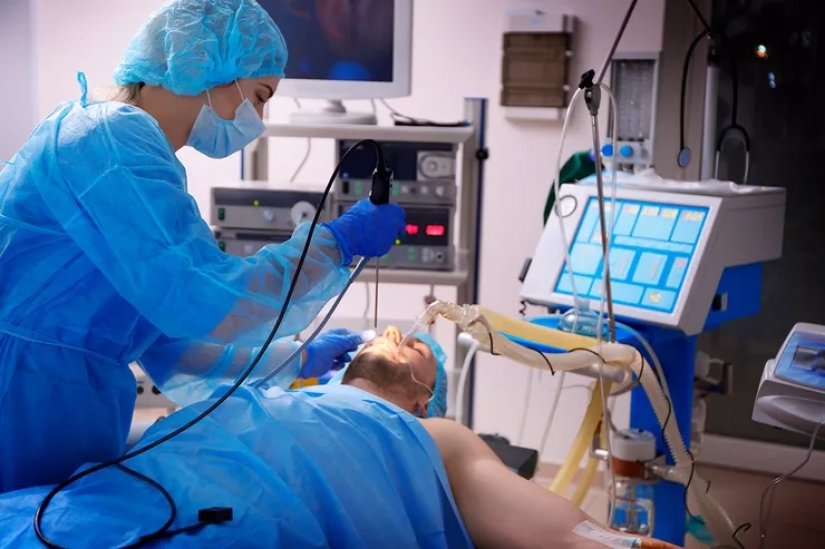
Modern devices for artificial ventilation of lungs we see in the series about a genius or just selfless doctors. Very often such devices are disparagingly referred to as "fans", but they, of course, far more complex. Inside the machine not only pumps air, but also a special capacity-humidifier so that the air was not dried the respiratory system.
The apparatus can be connected in two ways: using masks on the face or, in more severe cases, through a tube in the trachea (i.e., making the intubation — "in" means "inside", "tube" — tube). Because very often the problem is not only the ability to breathe, but also the ability to absorb oxygen, then fed oxygen — so at least something went in blood.
In addition to oxygen can be fed into the lungs, and gases for medical purposes. For the machine to fully regulate the breath, not engaging in a struggle with their own muscles of the patient, the patient is injected with a substance that relaxes the diaphragm. Removed from a ventilator, usually in several stages, observing the reaction of the body.
When artificial ventilation was a long, gradually begin to reduce the options, especially those that can lead to serious side effects. Support light gradually ceases, the patient begins to breathe better. Short-term use of the device for a long period of disconnection is required, it is kept until the end of anesthetic.
Ventilators do not use "in any unclear situation". The fact that the injection of air still carries a risk of damage to delicate lung tissue, so to that extent, resort to extreme, in very severe cases, when there is a choice between the chance to survive, but to cripple, or not to survive at all.
The network is now discussing what only one-fifth of patients with coronavirus, a case which reached the ventilator survives. Doctors insist: it's not "only" the fifth part, and as much as twenty percent versus zero. When it comes to human life, this is an important difference.
Keywords: Apparatus | Breathing | Invention | Light | Treatment | Medicine | Rescue
Recent articles

In early 18th-century Paris, his name was whispered—Cartouche. For some, he was a daring robber and the leader of a desperate ...
The name of the photographer is not known to everyone, but it is difficult to find a person who is not familiar with his works. ...
Related articles

We all sometimes there are days when it is boring. The series is no longer pleasing, the weather "bad", all your friends are busy ...

When people only dreamed of the remote control. Now that we've switched the channels on the TV with a plastic thing that is ...

The Victorian era began in 1837 with the arrival of Queen Victoria and lasted until 1901. During this period, people managed to ...

Like all cuisines of the East, Vietnamese gastronomy is balanced and nutritious. Many of its traditions are borrowed from China and ...